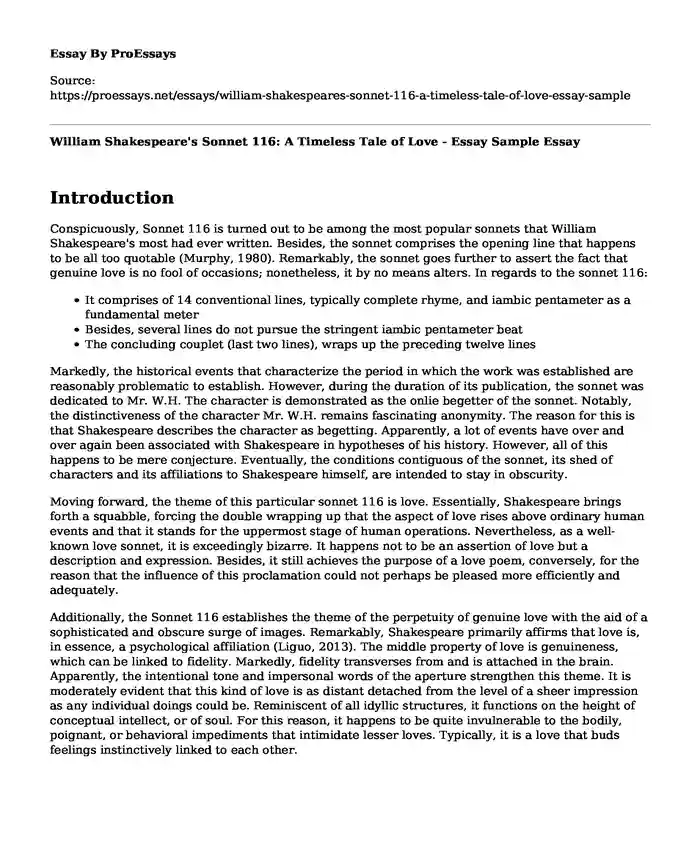Introduction
Conspicuously, Sonnet 116 is turned out to be among the most popular sonnets that William Shakespeare's most had ever written. Besides, the sonnet comprises the opening line that happens to be all too quotable (Murphy, 1980). Remarkably, the sonnet goes further to assert the fact that genuine love is no fool of occasions; nonetheless, it by no means alters. In regards to the sonnet 116:
- It comprises of 14 conventional lines, typically complete rhyme, and iambic pentameter as a fundamental meter
- Besides, several lines do not pursue the stringent iambic pentameter beat
- The concluding couplet (last two lines), wraps up the preceding twelve lines
Markedly, the historical events that characterize the period in which the work was established are reasonably problematic to establish. However, during the duration of its publication, the sonnet was dedicated to Mr. W.H. The character is demonstrated as the onlie begetter of the sonnet. Notably, the distinctiveness of the character Mr. W.H. remains fascinating anonymity. The reason for this is that Shakespeare describes the character as begetting. Apparently, a lot of events have over and over again been associated with Shakespeare in hypotheses of his history. However, all of this happens to be mere conjecture. Eventually, the conditions contiguous of the sonnet, its shed of characters and its affiliations to Shakespeare himself, are intended to stay in obscurity.
Moving forward, the theme of this particular sonnet 116 is love. Essentially, Shakespeare brings forth a squabble, forcing the double wrapping up that the aspect of love rises above ordinary human events and that it stands for the uppermost stage of human operations. Nevertheless, as a well-known love sonnet, it is exceedingly bizarre. It happens not to be an assertion of love but a description and expression. Besides, it still achieves the purpose of a love poem, conversely, for the reason that the influence of this proclamation could not perhaps be pleased more efficiently and adequately.
Additionally, the Sonnet 116 establishes the theme of the perpetuity of genuine love with the aid of a sophisticated and obscure surge of images. Remarkably, Shakespeare primarily affirms that love is, in essence, a psychological affiliation (Liguo, 2013). The middle property of love is genuineness, which can be linked to fidelity. Markedly, fidelity transverses from and is attached in the brain. Apparently, the intentional tone and impersonal words of the aperture strengthen this theme. It is moderately evident that this kind of love is as distant detached from the level of a sheer impression as any individual doings could be. Reminiscent of all idyllic structures, it functions on the height of conceptual intellect, or of soul. For this reason, it happens to be quite invulnerable to the bodily, poignant, or behavioral impediments that intimidate lesser loves. Typically, it is a love that buds feelings instinctively linked to each other.
Conclusion
In conclusion, William Shakespeare's contributions to the aspect of humanity have been, to a vast extent, indispensable. Remarkably, he has contributed appreciably to the augmentation of English terminologies and expressions, which have enhanced the language prompting it to be more vivid and communicative. Additionally, his manipulate on aspects such as art, literature, speech, and the enormous collection of the imaginative illustrations has, for the longest time, been known, appreciated, and also documented. William Shakespeare happens to be the most-read writer in globally, and the amazingly the English language is beleaguered with all manner of quotes and expressions that have been derived from his manuscripts. William Shakespeare is also the discoverer of the element of iambic pentameter, a structure of poetry that is still extensively utilized in the modern world.
References
Murphy, G. N. (1980). Shakespeare's Sonnet 116. The Explicator, 39(1), 39-41. Retrieved from https://www.tandfonline.com/doi/pdf/10.1080/00144940.1980.11483423
Liguo, L. (2013). On the Dispute of the Theme of Love in Shakespeare's Sonnets. Higher Vocational Studies of Changzhou Institute of Engineering Technology, (1), 14. Retrieved from http://en.cnki.com.cn/Article_en/CJFDTotal-CGGG201301014.htm
Cite this page
William Shakespeare's Sonnet 116: A Timeless Tale of Love - Essay Sample. (2023, Apr 24). Retrieved from https://proessays.net/essays/william-shakespeares-sonnet-116-a-timeless-tale-of-love-essay-sample
If you are the original author of this essay and no longer wish to have it published on the ProEssays website, please click below to request its removal:
- A Literary Essay Sample: Ordinary Men Response
- Critique of Dissent From War by Robert Ivie Essay
- Cultural Identity in Rodolfo Corky Gonzalez's I Am Joaquin
- "The Yellow Paper" Theme of Freedom Essay
- Essay on Everyday Use and Glass Menagerie: Family Struggles and Complexities
- Reflection on the Movie 12 Angry Men
- Edgar Allan Poe: A Bibliographic Analysis of Sources - Annotated Bibliography







